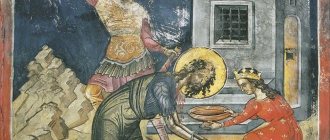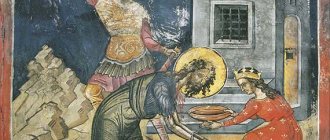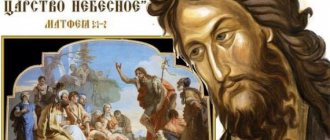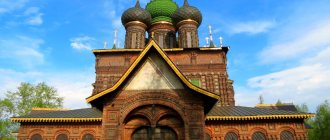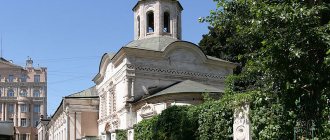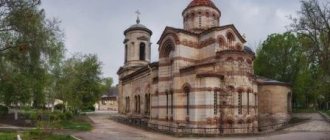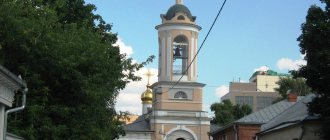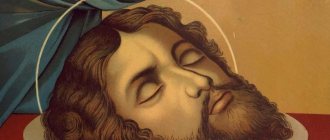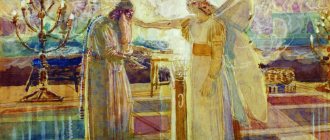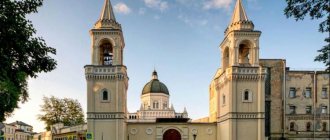Dyakovo Church of the Beheading of John the Baptist is a historically and architecturally unique temple. The reason for construction is considered to be the adoption of the title of Tsar by 16-year-old Ivan the Fourth in 1547. The Baptist Church is one of two that survived, consisting of several on a common foundation, or multi-pillared. The second is the Intercession Cathedral on the Moat, built to commemorate the capture of Kazan in 1552. The assault began on the day of the Intercession, but this masterpiece is better known as St. Basil's Cathedral.
The Church of the Beheading of John the Baptist and the Moscow church had a similar external design in common. Both buildings were red and white, the church was depicted this way by the artist Makovsky, the cathedral was painted by many and many times. The current appearance of St. Basil's Cathedral is well known; the transformed snow-white Church of the Beheading of John the Baptist is in harmony with the Church of the Ascension of the Lord in Kolomenskoye, 400 meters away.
Scientists still have not established exactly when the Church of the Beheading of John the Baptist was built. Strange, but the announced dates cover almost the entire period of the reign of Ivan the Terrible and his entire life. It’s doubly strange, because the timing of the royal crowning does not cause any controversy. At the same time, they speak with sufficient confidence about the builders of the temple, architects with the nicknames Barma and Postnik.
These same builders are considered the authors of St. Basil's Cathedral, and the Church of the Beheading of John the Baptist is considered a warm-up for the capital project. Structurally, the temples are indeed united by a common technical solution, but only at the level of a single foundation. The nine-domed cathedral with a hipped central church and the church of five pillars with a middle one similar to a rotunda are very different.
The number of chapters of both the cathedral glorified by the bill and the church in Dyakovo corresponds to the number of individual churches. They are connected by vestibules, like the chapels and the main volume of cross religious buildings, the most common in Orthodoxy. Visitors can fully examine the Church of the Beheading of John the Baptist and appreciate its features and merits by approaching the temple.
Church of the Beheading of John the Baptist near
Although only the main dome is visible in the photo from distant angles, the Church of the Beheading of John the Baptist stands on an elevated site. A path in the forest leads to the temple fence, equipped with a brick gate. The time of their construction is unknown, but their good state of preservation indicates their recent origin. The large arch of the passage inside forms two incomplete ones, joining in the middle.
On the sides of the passage there are two more small arches, one of them covered with bricks. The second one is equipped with a gate for pedestrian passage. All arches are covered with metal sheets; at the highest points there are pedestals with domes and crosses. The central pediment is decorated with an icon of John the Baptist, otherwise called the Baptist. The nicknames reflect the prediction he made about the appearance of Christ and the baptism of the future Savior.
The church grounds are not particularly well-groomed; the graves overgrown with grass are evidence of this. Most of the stone tombstones are overgrown with moss; some crosses have become askew due to the settling of the grave mounds. At the same time, preserved wreaths and artificial flowers are noticeable on some monuments. The church cemetery, of course, has not been active for a long time, although it remains in relative order.
The burial of local residents here was stopped in the 1930s, when the temple was no longer in operation. The ongoing archaeological excavations, the purpose of which was to search for the famous library of Ivan the Terrible, were also forced to be curtailed. Further deepening threatened to violate the integrity of the foundation, which could cause the Church of the Beheading of John the Baptist to lose stability. The famous Liberia has not yet been found.
Architectural features
The cross construction of the temple is expressed here in the arrangement of four small churches diagonally to the parts of the world. The larger central building, as expected, has an altar in the east and a main entrance in the west. The octagonal side churches consist of two tiers, between which there is a jagged ridge of stylized kokoshniks. These churches are connected by vestibules to the main one, and the two adjacent to the western wall merge with it.
The western wall contains the entrance to the Church of the Beheading of John the Baptist, and the original belfry is located on it. Typically, the bells of Orthodox churches are placed in a high tower, built into the building or standing separately. Here, for this purpose, a design is used that is a continuation of the front facade. A bit reminiscent of the St. Sophia Belfry in Veliky Novgorod.
The drum of the dome of the central structure also looks unusual, like a rotunda with closely spaced columns. This detail will be shown even closer while we look at the belfry. The pointed structure has three pillars and, accordingly, two openings in which the load-bearing beams are fixed. The pillars seem to be composed of unequal parts, varied by rectangular recesses.
The openings formed between the pillars for bells with sharp ends are clearly of different sizes. Apparently, their width was chosen based on the size of the bells that were supposed to be placed on the belfry. The ladder and ladder for bell ringers are not protected from precipitation and wind, as in traditional bell towers. The bell level is located level with the domes of small churches, the crosses of which reach only the middle of the belfry.
The entrance doors to the Church of the Beheading of John the Baptist are located directly under the belfry. Above the doors with an open door, supported by a chair, there is an image of the holy martyr. Apart from the round arch above the entrance, the rest of the decorative elements are sharp or rectangular. There is a sign on the wall with the name of the temple, and the few window openings are equipped with bars.
In the fifth century of its existence, the Church of the Beheading of John the Baptist was not going through the best of times. Closing by the Bolsheviks in 1924, opening in 1949 and new oblivion since 1957. The last consecration of this most valuable historical and religious building took place in 1992. To complete the impression, let’s go inside, as the announcement at the entrance invites.
Pilgrim[edit]
Schedule of services:
Morning services on Saturdays, Patronal, Great holidays and on days of remembrance of especially revered saints and icons of the Mother of God. Morning services begin at 8:00.
Evening services are scheduled for Sundays (Saturdays) and major holidays and begin at 18:00.
On Fridays, services are held in the assigned Hospital Church in the name of the holy passion-bearer, blessed Tsarevich Alexy at PKB No. 15 in Moscow. Services begin at 8:00.
Interior of the Church of the Baptist
The interior decoration of the Church of the Beheading of John the Baptist does not differ from ordinary Orthodox churches. The altar barrier is made in the form of an iconostasis consisting of several rows of images of saints. The doors of the Holy Gates, intended for the passage of priests into the altar room, are also decorated with icons. All traditional attributes are present, from the solea podium with a raised pulpit for preaching to the choir for choristers, lecterns and candlesticks.
The lecterns for festive icons are covered with covers that match the colors of the priests’ attire appropriate for the day. Holy images are available for ritual kisses; leafing through church books is not prohibited. Both believers and atheists light health and funeral candles in the church. To examine all the tiers of the iconostasis, you have to move further away; the images crowned with a cross rise in ledges to the top of the windows.
This arrangement of the altar barrier was not formed immediately; it is typical only for Orthodox churches. Among Catholics, the altar is often also fenced off from the parishioners, but mainly purely symbolically. This is either an openwork metal lattice or a low balustrade. This significant difference resulted from the division of branches of Christianity, emphasizing larger ideological differences.
Several narrow and long side windows provide natural light into the Church of the Beheading of John the Baptist. One tier above are eight openings in the wide part of the drum, and above them there are the same number under the dome itself. Having left the temple, most of those who visited the ancient structure again examine it from the outside, marveling at the harmony of its appearance.
A careful examination of the light drum of the central dome allows you to understand its structure. This is not a rotunda, but halves of cylindrical towers, between which are the windows of the second tier. Multiple holes in the upper parts of the towers, apparently, were not through; they were not discovered from the inside. But the windows of the second tier, which were clearly visible during the visit, are not visible from below.
Patronal holidays[edit]
Beheading of the Prophet, Forerunner and Baptist of the Lord John
- 11 September
John the Baptist, prophet
— July 7 (Christmas), September 11 (Beheading), October 6 (Conception), January 20 – Council
Cathedral of the 12 Apostles
- July 13
Conception of John the Baptist - October 6
Conception of the Blessed Virgin Mary by Righteous Anna
— December 22
Constantine and Helen, Equal to the Apostles
— June 3
Cathedral of Moscow Saints
— October 18
Architecture and interior decoration
The temple complex includes several buildings:
- the church itself from the 17th century;
- refectory of the 18th century;
- bell tower of the 18th century;
- church house.
Exterior of the church, © Nomad
The temple is a tetrahedral, single-domed stone structure with semi-domes rising in the center of the facades. Above the dome there is a high lantern crowned with an onion-shaped dome and a gilded cross. On the eastern side of the building there is a semicircular apse, covered with a conch, and on the western side there is a vestibule.
Large windows were cut through during the reconstruction of the church in the middle of the 18th century. Part of the architectural decor, for example the original framing of the southern entrance portal, was preserved in the original, the rest was restored from surviving fragments.
Almost nothing remains of the original interior decoration of the temple, only a tiny fragment of a fresco, which was preserved “for posterity” during the latest restoration work. The current rich painting of the walls and vaults is made in the Byzantine style. It is based on scenes from the life of John the Baptist.
The refectory is closely adjacent to the church and its southern façade faces the “red line” of Chernigovsky lane. Despite the close proximity, the objects look like independent units. The vaulted building is decorated with pilasters, with platbands around the window openings, visually supported by curlicue consoles and crowned with pediments. The external entrance to the refectory is located at the western end.
Refectory, © Ludvig14
Between the refectory and the bell tower there is a lattice fence with a stone base and massive pillars. It was restored during restoration work in 1984 in proportions close to the original, but without the interrupting church porch. The fence is the unifying link of the complex.
The 2-3 storey church house is located across the road from the refectory. Its appearance does not correspond to the one-story original of 1798, intended as an almshouse. The building “grew up” already in the 19th century, and the facades were changed at the same time.
Bell tower from the side of the Cast Iron Bridge, © Nomad
Vow to God
The first wooden church was founded by Prince Vasily III as a vow for the birth of a son. The prince waited for an heir for 20 years. For his sake, he divorced his wife Solomonia Saburova and married the beautiful Polish woman Elena Glinskaya. In 1530, the temple was completed in honor of the birth of Prince John (the future Tsar Ivan the Terrible).
The wooden temple, according to legend, burned down. Scientists date the laying of the foundation of the existing one to 1547. It appeared on the border of architectural eras: tent-roofed and pillar-shaped churches, in honor of the accession to the royal throne of young John IV.
There are only two such churches in Russia: in Dyakovo and Pokrovsky, known as St. Basil's Cathedral. They have many common details, which allows us to name the author: Pskov master Posnik. Initially, both temples were white and red. The current design of St. Basil's is a matter of more recent times.
Temple in Dyakovo
The austere, majestic five-pillar temple rises on the steep bank of the river and fits perfectly into the surrounding landscape. It is made in the style of ancient Russian tent churches, but ends with a flat dome. The main pillar, 34 m high (without the cross), is surrounded by 4 independent octagonal chapels with barrel towers. The composition stands on a single foundation and is united by a covered bypass gallery.
The pillars symbolize the continuity of power of Moscow rulers. The three domes hint at the Cathedrals of the Assumption in Vladimir, the Kremlin, and the Kiev Pechersk Lavra. Two point to the legacy of previous churches.
